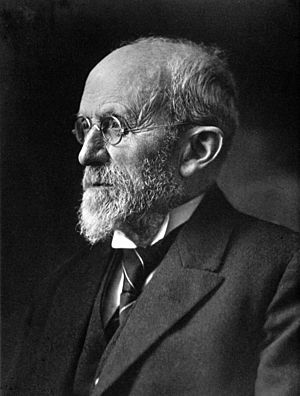Richard Hertwig facts for kids
Richard Wilhelm Karl Theodor Ritter von Hertwig (born September 23, 1850, in Friedberg, Hesse – died October 3, 1937, in Schlederloh, Bavaria), also known as Richard Hertwig, was a famous German zoologist. He was a professor for 50 years. He is well-known for being the first to correctly describe how a zygote forms. A zygote is the very first cell of a new living thing. He explained that it happens when a sperm cell joins with an egg cell inside the egg's outer layer during fertilization.
Richard Hertwig was the younger brother of Oscar Hertwig, who also studied how zygotes form. Both brothers were important students of Ernst Haeckel, a famous biologist. They both became professors in Germany. They used Haeckel's ideas to help them understand more about zoology. From 1879 to 1883, they worked together. They studied how living things develop, especially focusing on the idea of the coelom (a body cavity). Their work was based on Haeckel's ideas about how species evolve, like his "biogenic theory" and "gastraea theory."
After about 10 years, the brothers moved to different parts of Germany. Richard's brother Oscar became a professor of anatomy in Berlin in 1888. Richard Hertwig had moved three years earlier. He became a professor of zoology in Munich in 1885. He stayed there until 1925 at Ludwig Maximilians University. He spent 40 years of his 50-year teaching career at this university.
Later in his career, Richard Hertwig studied tiny living things called protists. He looked at how the nucleus (the control center of a cell) relates to the plasma (the jelly-like substance inside a cell). He also studied how sea urchins and frogs develop. Richard Hertwig also wrote a very important zoology textbook. It was first published in 1891 and was updated 15 times until 1931.
Life and Career
Hertwig was born in Friedberg, in the Grand Duchy of Hesse. He started studying medicine at the University of Jena. But he became very interested in zoology and biology because of his professor, Ernst Haeckel.
In 1872, he earned his doctorate degree at the University of Bonn. He then worked there as an assistant to Max Schultze, an anatomist. In 1875, he moved to the University of Jena to work in the Department of Zoology. In 1878, Hertwig became a special professor there.
In 1881, Richard Hertwig was appointed as a professor of zoology at the University of Königsberg. He took over from Franz Hermann Troschel. In 1883, he moved to the University of Bonn for the same job. However, he only stayed there for a short time. In 1885, he was asked to join the Ludwig Maximilians University in Munich. Hertwig stayed in Munich until 1925. He also led the zoological collection for the state of Bavaria. This collection is now called the Zoologische Staatssammlung München. He also directed the zoological institute, which he helped make into a top center for biological science.
Hertwig became a member of the Bavarian Academy of Sciences. He joined as a special member in 1885 and became a full member in 1889. In 1909, he received the title Ritter von. This was a special honor.
Hertwig passed away on October 3, 1937, in Schlederloh, Germany.
Many of his students became famous scientists. His student Otto Koehler helped start the study of Ethology (animal behavior) in Germany. Another student, Ivan Buresh, was a leading natural scientist in Bulgaria. His student Rhoda Erdmann was known for her work on invertebrates (animals without backbones) and cancer. She was a pioneer in growing tissues in a lab. She started and led the Institute of Experimental Cytology at the University of Berlin. She also started and edited a science journal.
Research and Discoveries
At the start of his career, Richard Hertwig worked closely with his brother, Oscar Hertwig. In 1881, they developed the Coelom Theory. This theory explained the coelom, which is a fluid-filled body cavity. This idea helped scientists understand more about embryology, which is the study of how living things develop before birth. The theory suggests that all organs and tissues grow differently from three main tissue layers during an animal's early development.
Hertwig studied many different groups of protozoa (single-celled organisms) and metazoa (multi-celled animals without backbones). He made important discoveries about how animals develop. His most famous work is in the field of protozoa research.
Hertwig studied sea urchins very closely. Based on his observations, he was the first to correctly explain the zygote fertilization process. He showed that it is the joining of an egg cell and a sperm cell that enters the egg's outer layer.
See also
 In Spanish: Richard Hertwig para niños
In Spanish: Richard Hertwig para niños


